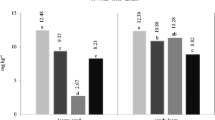Abstract
Experiments were conducted both under in vitro and in situ conditions to determine the biodegradation potential of button mushroom spent substrate (SMS) and its dominating microbes (fungi and bacteria) for carbendazim and mancozeb, the commonly used agricultural fungicides. During 6 days of incubation at 30 ± 2°C under broth culture conditions, highest degradation of carbendazim (17.45%) was recorded with B-1 bacterial isolate, while highest degradation of mancozeb (18.05%) was recorded with Trichoderma sp. In fungicide pre-mixed sterilized SMS, highest degradation of carbendazim (100.00–66.50 μg g−1) was recorded with mixed inoculum of Trichoderma sp. and Aspergillus sp., whereas highest degradation of mancozeb (100.00–50.50 μg g−1) was with mixed inoculum of Trichoderma sp., Aspergillus sp. and B–I bacterial isolate in 15 days of incubation at 30 ± 2°C. All these microbes both individually as well as in different combinations grew well and produced extracellular lignolytic enzymes on SMS, which helped in fungicides degradation. Under in situ conditions, among three different proportions of SMS (10, 20 and 30%, w/w) mixed with fungicide pre-mixed soil (100 μg g−1 of soil), the degradation of carbendazim was highest in 30% SMS treatment, while for mancozeb it was in 20% SMS treatment. The residue levels of both fungicides decreased to half of their initial concentration after 1 month of SMS mixing.




Similar content being viewed by others
References
Ahlawat OP, Pardeep Gupta, Satish Kumar (2007) Spent mushroom substrate–a tool for bioremediation. In: Rai RD, Singh SK, Yadav MC, Tewari RP (eds) Mushroom biology biotechnology. Mushroom society of India, national research centre for mushroom, Solan, India, pp 341–366
Guthrie RK, Davis EM (1985) Biodegradation of effluents. In: Mizrahi A, Van Wezel AL (eds) Advances in biotechnological processes, vol 5. Alan Liss, New York, pp 149–152
Pill WG, Evans TA, Garrison SA (1993) Forcing white button asparagus in various substrates under cool and warm regimes. Hort Sci 28(10):996–998
Buswell JA (1995) Potential of spent mushroom substrate for bioremediation purposes. Mushroom News 43(5):28–34
Semple KT, Fermor TR (1995) The bioremediation of xenobiotic-contamination by composts and associated microflora. Mushroom Sci XIV(II):917–924
Hofrichter M, Scheibner K, Sack U, Fritsche W (1997) Degradative capacities of white-rot and litter decaying fungi for persistent natural and xenobiotic compounds. In: Rai RD, Dhar BL, Verma RN (eds) Advances in mushroom biology, production. Mushroom Society of India, NRCM, Solan, India, pp 271–280
Ahlawat OP, Raj D, Sagar MP, Gupta P, Vijay B (2006) Effect of recomposted spent mushroom substrate on yield and quality of cauliflower (Brassica oleracea L. var. botrytis). Mushroom Res 15(2):149–152
Ahlawat OP, Raj D, Sagar MP, Gupta P, Vijay B (2006) Effect of recomposted button mushroom spent substrate on growth, yield and quality of ginger (Zingiber officinale). Indian J Mushrooms 24(1&2):13–18
Ahlawat OP, Sagar MP, Raj D , Indu Rani C, Gupta P, Vijay B (2007) Effect of spent mushroom substrate on yield and quality of capsicum (Capsicum annuum). Indian J Hort 64(4):430–434
Ahlawat OP, Sagar MP, Raj D, Gupta P, Vijay B (2007) Effect of recomposted button mushroom spent substrate on growth and yield attributes of wheat (Triticum aestivum L). Mushroom Res 16(1):41–46
Pannier W (1993) Spent mushroom compost, a natural resource that provides solutions to environmental problems. Mushroom News 41(11):10–11
Dubey JK, Stan HJ (1998) Second derivative UV-spectrophotometeric determination of dithiocarbamate residues as methylxanthate in apple and lamb’s lettuce. J Food Sci Technol 35(6):482–485
Deutsch Forschungsgemeinschaft (DFG) (1987) Manual of pesticide residue analysis. In: Their HP, Zeumer H (eds) Pesticide Commission, vol 1 & 2. VCH, Weinheim
Nath A, Patyal SK, Dubey JK (1993) A new protocol for rapid sample preparation for spectrophotometric estimation of carbendazim residue in apple, tomato and mushroom. J Food Sci Technol 30:239–240
Huang JW, Hu CK, Tzeng DDS, Ng KH (1995) Effect of soil amended with spent golden mushroom compost on alleviating phytotoxicity of alachlor to seedling of garden pea. Plant Pathol Bull 4(2):76–82
Huang JW, Hu CK, Shih SD (1996) The role of soil microorganism in alleviations of root injury of garden pea seedlings by alachlor with spent golden mushroom compost. Plant Pathol Bull 5(3):137–145
Carbendazim. Kingtai Chemicals Co Ltd. http://www.kingtaichem.com
Eggen T, Sasek V (2002) Use of edible and medicinal oyster mushroom (Pleurotus ostrearus (Jacq: Fr) kumm) spent compost in remediation of chemically polluted soils. Int J Med Mushrooms 4(3):255–261
Buswell JA (1994) Potential of spent mushroom substrate for bioremediation purposes. Compost Sci Util 2(3):31–36
Femor T, Wastls N, Duncombe T, Brooke R, McCarthy A, Semple K, Reid B (2000) Bioremediation: use of composts and composting technologies. Mushroom Sci XV(II):833–839
Tekere M, Ncube I, Read J, Zvauya (2002) Biodegradation of the organochlorine pesticides, lindane by a sub-tropical white rot fungus in batch and packed bed bioreactor systems. Environ Technol 23:199–206
Hestbjerg HP, Willumsen A, Chrostensen M, Andersen O, Jacobsen CS (2003) Bioaugmetnation of tar-contaminated soils under field conditions using Pleurotus ostreatus refuse from commercial mushroom production. Environ Toxicol Chem 22(4):692–698
Lau KL, Tsang YY, Chiu SW (2003) Use of spent mushroom compost to bioremediate PAH-contaminated samples. Chemosphere 52:1539–1546
Law W, Lau W, Lo K, Wai L, Chiu S (2003) Removal of biocide pentachlorophenol in water system by the spent mushroom compost of Pleurotus pulmonarius. Chemosphere 52(9):1531–1537
Acknowledgment
The authors are thankful to Director, Directorate of Mushroom Research, Solan (HP), India for providing necessary research facilities for the study and Indian Council of Agricultural Research, New Delhi for financing the AP-Cess Scheme.
Author information
Authors and Affiliations
Corresponding author
Rights and permissions
About this article
Cite this article
Ahlawat, O.P., Gupta, P., Kumar, S. et al. Bioremediation of Fungicides by Spent Mushroom Substrate and Its Associated Microflora. Indian J Microbiol 50, 390–395 (2010). https://doi.org/10.1007/s12088-011-0067-8
Received:
Accepted:
Published:
Issue Date:
DOI: https://doi.org/10.1007/s12088-011-0067-8




